Power Tools Market
Power Tools Market Size and Share Forecast Outlook 2025 to 2035
Power tools market is projected to grow from USD 34.7 billion in 2025 to USD 86.5 billion by 2035, at a CAGR of 9.6%. Drills will dominate with a 29.4% market share, while cordless will lead the mode of operation segment with a 63.1% share.
Power Tools Market Forecast and Outlook 2025 to 2035
The global power tools market is set to grow from USD 34.7 billion in 2025 to USD 86.5 billion by 2035, adding USD 51.8 billion in new revenue and advancing at a CAGR of 9.6%. Growth is driven by escalating demand for cordless tool technologies in construction applications, expanding automation infrastructure across manufacturing sectors, and accelerating adoption of battery-powered equipment among professional contractors seeking mobility and productivity enhancement solutions.
Power tool technologies are increasingly recognized as essential equipment for industrial operations and residential projects, offering enhanced efficiency capabilities, ergonomic design improvements, and wireless operation characteristics compared to traditional manual tool approaches.
Quick Stats for Power Tools Market
- Power Tools Market Value (2025): USD 34.7 billion
- Power Tools Market Forecast Value (2035): USD 86.5 billion
- Power Tools Market Forecast CAGR: 9.6%
- Leading Product in Power Tools Market: Drills (29.4%)
- Key Growth Regions in Power Tools Market: Asia Pacific, North America, and Europe
- Top Players in Power Tools Market: Bosch, Stanley Black & Decker, Makita Corporation, Hilti Corporation, Techtronic Industries
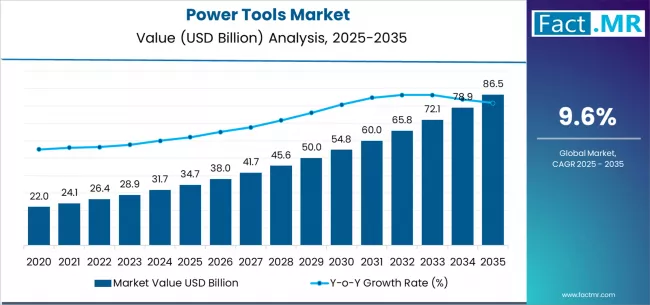
Cordless tools are favored in construction and industrial environments for their operational flexibility advantages, providing unrestricted movement capabilities, job site productivity optimization, and lithium-ion battery performance across diverse application requirements and professional user segments.
Industrial applications remain fundamental in power tool deployment where production efficiency priorities and precision operation requirements match manufacturing process standards and quality assurance protocols. Drills are advancing among product categories as versatile functionality demand increases and multi-application capabilities enhance tool utilization in professional construction facilities with comprehensive drilling and fastening requirements.
Geographic concentration demonstrates dynamic growth patterns with India and China driving expansion, supported by rising construction activity levels, manufacturing capacity development among industrial sectors, and infrastructure investment programs in urban development projects.
The USA, Germany, Japan, UK, and South Korea demonstrate robust development through established construction industry ecosystems, tool technology innovation maturity, and professional contractor expertise in advanced power equipment utilization. Competitive advantage is consolidating around battery technology performance, brushless motor efficiency, ergonomic design excellence, and integrated tool system portfolios rather than standalone power tool offerings alone.
The first half of the decade will witness substantial market expansion characterized by the continued dominance of cordless technologies in professional applications, combined with accelerating adoption of smart tool platforms in industrial settings where connectivity features and USAge monitoring create favorable productivity optimization outcomes. The latter half will witness sustained expansion defined by broadening acceptance of artificial intelligence integration and deployment of predictive maintenance systems across mainstream construction and manufacturing operations.
Market momentum will intensify as contractors and manufacturers increasingly prioritize advanced power tool platforms that deliver operational efficiency enhancements, worker safety improvements, and total cost of ownership advantages across diverse project environments and application demands.
Where revenue comes from - Now Vs Next (industry-level view)
| Period | Primary Revenue Buckets | Share | Notes |
|---|---|---|---|
| Today | Drills | 29.4% | Versatile application leadership |
| Cordless Tools | 63.1% | Operational flexibility dominance | |
| Industrial Applications | 46.5% | Primary end-use segment | |
| Saws | 22.7% | Cutting application leadership | |
| Residential Applications | 34.2% | DIY market expansion | |
| Future (3-5 yrs) | Smart Connected Tools | 38-44% | IoT integration |
| Brushless Motor Systems | 42-48% | Efficiency advancement | |
| Modular Battery Platforms | 35-41% | System interoperability | |
| Robotic Power Tools | 22-28% | Automation integration | |
| Sustainable Tool Materials | 28-34% | Circular economy | |
| AI-Powered Diagnostics | 25-31% | Predictive maintenance | |
| Augmented Reality Guidance | 18-24% | Training enhancement |
Power Tools Market Key Takeaways
At-a-Glance Metrics
| Metric | Value |
|---|---|
| Market Value (2025) → | USD 34.7 billion |
| Market Forecast (2035) ↑ | USD 86.5 billion |
| Growth Rate ★ | 9.6% CAGR |
| Leading Product → | Drills |
| Primary Application → | Industrial |
The market demonstrates exceptional fundamentals with drills capturing a commanding 29.4% share through versatile application characteristics, multi-functional capabilities, and established performance profiles across construction and manufacturing operations. Industrial applications drive primary utilization at 46.5% share, supported by established manufacturing infrastructure and precision operation requirements that maintain contractor confidence across diverse production environments.
Geographic concentration remains anchored in Asia Pacific and North America with emerging market leadership through construction activity expansion and manufacturing capacity development, while developed markets show accelerated adoption rates driven by automation initiatives and cordless technology preferences.
Imperatives for Stakeholders in Power Tools Market
Design for performance and durability, not just power ouTPUt
- Offer complete tool solutions: advanced power tool platforms + battery ecosystem integration + safety feature systems + maintenance protocols + productivity monitoring applications.
- Preconfigured tool packages: professional drill sets, specialized SAW configurations, industrial fastening systems, and comprehensive contractor kits for diverse project requirements.
Innovation readiness for connected tool applications
- Comprehensive IoT integration capabilities, USAge data analytics systems, and supply chain quality assurance (durability testing, safety certifications, performance validation protocols).
Value-by-design approach
- Cost-optimized product portfolios, flexible purchasing models, trade professional programs, and transparent total ownership cost documentation.
Professional training-focused market penetration
- Established demonstration facilities + comprehensive safety certification programs (proper USAge techniques, maintenance procedures, hazard prevention); direct contractor engagement for relationship development and brand loyalty building.
Segmental Analysis
The market segments by product into drills, saws, sanders, wrenches, and others including grinders, routers, and polishers, representing the evolution from basic power assistance toward sophisticated multi-functional platforms with enhanced precision control, safety integration, and application versatility characteristics.
The mode of operation segmentation divides the market into cordless (63.1%) and corded systems, reflecting distinct power delivery approaches for mobility optimization and battery technology advancement versus continuous power availability and unlimited runtime requirements. The application segmentation shows industrial's commanding 46.5% position, followed by residential and commercial sectors, demonstrating varied USAge intensity levels and professional expertise concentrations.
What makes Drills Command the Largest Share in the Power Tools Market?
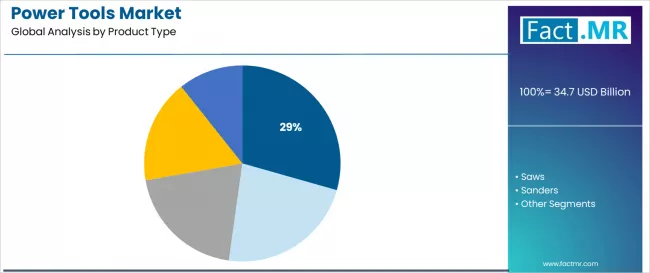
Drills command the leading position in the power tools market with a 29.4% market share through versatile application characteristics, including drilling operations, fastening capabilities, and multi-functional attachments that enable contractors to achieve comprehensive project execution across varied construction tasks and diverse material types.
The segment benefits from universal application advantages through wood, metal, and masonry drilling capabilities, established user familiarity, and proven reliability documentation without requiring specialized equipment for basic operations. Advanced motor technology enables torque optimization, speed control precision, and clutch setting customization, where drilling accuracy and material compatibility represent critical performance requirements.
Hammer drill configurations hold significant share within the product segment, appealing to contractors seeking masonry drilling capabilities for comprehensive construction applications. Drill products differentiate through proven versatility performance, contractor preference advantages, and integration with established tool ecosystems that enhance purchasing confidence while maintaining cost-effectiveness for diverse construction and manufacturing applications.
Key market characteristics:
- Advanced chuck systems with optimized bit retention and quick-change capabilities for operational efficiency
- Superior battery integration, enabling extended runtime and rapid charging for productivity maintenance
- Comprehensive safety features, including electronic clutches, LED work lights, and anti-kickback protection for operator safety
Why do Saws Represent Critical Cutting Operation Segments?
Saws maintain specialized market position at 22.7% share through essential cutting operation capabilities and material separation requirements. These products appeal to contractors seeking specialized cutting platforms with blade technology advantages and precision cutting control, offering varied cutting depth adjustment and bevel angle capabilities through diverse SAW type configurations.
Market adoption is driven by circular SAW portability, reciprocating SAW demolition capabilities, and miter SAW precision requirements, emphasizing accurate cutting execution and material processing efficiency through specialized blade technologies.
By Mode of Operation, Which Category of Power Tools Dominate?
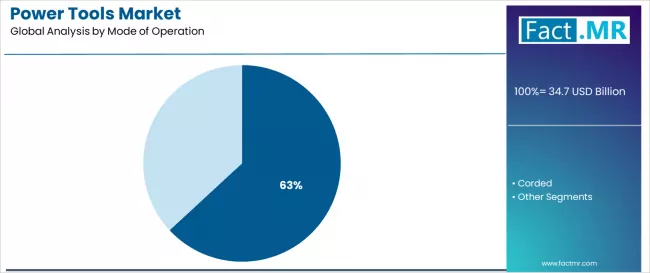
Cordless tools demonstrate operational leadership in the power tools market with a 63.1% share due to mobility advantages and established focus on job site flexibility, extension cord elimination, and operational freedom that maximizes productivity outcomes while maintaining sufficient power delivery characteristics.
Contractors prioritize cordless operations for construction site mobility, overhead work positioning, and integration with established battery platform ecosystems that enable coordinated tool utilization across multiple equipment categories. The segment benefits from substantial lithium-ion battery advancement and charging speed improvements that emphasize cordless-based approaches for professional construction applications across diverse job site environments.
Battery interoperability captures significant adoption within the cordless segment, demonstrating contractor preference for unified battery platform benefits. Professional contractor programs incorporate cordless tool optimization as standard equipment strategies for productivity enhancement, while safety requirements increase demand for cord-free operation integration with fall protection systems and confined space protocols for comprehensive job site safety outcomes.
What drives Corded Tool Adoption in Continuous Operation Applications?
Corded tools capture substantial mode share at 36.9% through comprehensive requirements in stationary workshop operations, unlimited runtime applications, and maximum power ouTPUt demands.
Corded power tools demand reliable electrical infrastructure capable of achieving consistent power delivery while providing continuous operation capabilities and maximum torque availability, appealing to industrial users seeking evidence-based performance advantages beyond battery-dependent cordless alternatives.
Which Application Area is the Leading Category in the Power Tools Market?
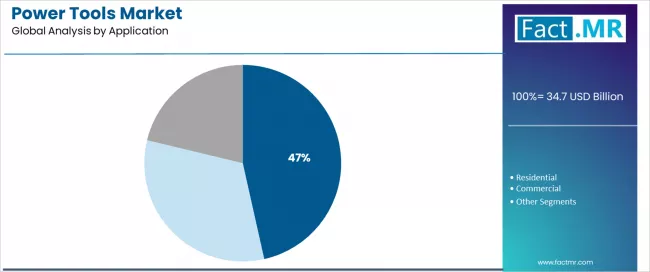
Industrial applications establish market leadership in the power tools market with a commanding 46.5% share due to comprehensive manufacturing requirements and sustained focus on production efficiency optimization, precision operation execution, and heavy-duty durability standards that maximize equipment utilization while maintaining appropriate safety compliance levels.
Manufacturers prioritize industrial tools for assembly line integration, quality control precision, and coordination with established production workflows that enable comprehensive manufacturing operations across extended operational shifts. The sector benefits from substantial professional user documentation and productivity measurement evidence that emphasizes industrial-grade power tools for manufacturing excellence applications.
Automation initiatives incorporate power tool integration as manufacturing optimization strategies for labor efficiency enhancement, while quality improvement requirements increase demand for torque-controlled fastening that meets assembly specification and traceability requirements.
Application dynamics include:
- Strong growth in automotive manufacturing requiring precision torque tools and assembly automation integration
- Increasing adoption in electronics production for miniaturized fastening and delicate component handling applications
- Rising integration with aerospace assembly operations for certified tool compliance and quality documentation requirements
How are Residential Applications Advancing DIY Market Requirements?
Residential applications capture substantial share at 34.2% through established homeowner project frameworks, DIY renovation activities, and home maintenance operations. The segment demonstrates growing consumer confidence across diverse project categories, with cordless convenience features and safety system integration gaining traction in home improvement programs while user-friendly designs drive continued market accessibility requiring careful balance between professional-grade performance and consumer-oriented simplicity.
What are the Drivers, Restraints, and Key Trends of the Power Tools Market?
| Category | Factor | Impact | Why It Matters |
|---|---|---|---|
| Driver | Rising construction activity & infrastructure development (urbanization, renovation projects) | ★★★★★ | Construction sector expansion enables power tool demand for building operations; increasing project complexity drives advanced tool adoption across professional contractor segments and residential renovation markets. |
| Driver | Growth in cordless battery technologies & lithium-ion advancement (runtime extension, charging speed) | ★★★★★ | Drives demand for mobile power tool systems and cord-free operation capabilities; manufacturers implementing advanced battery platforms gain competitive advantage in professional contractor segments. |
| Driver | Expansion of DIY culture & home improvement activities (consumer empowerment, content platforms) | ★★★★☆ | Homeowners demand accessible power tool solutions and user-friendly designs; DIY positioning expanding addressable segments beyond professional contractor markets and traditional industrial customers. |
| Restraint | High initial investment costs & premium pricing (battery systems, professional-grade tools) | ★★★★☆ | Cost-conscious buyers face affordability barriers and purchase hesitation; increases market entry challenges and affects adoption penetration in price-sensitive segments and emerging markets. |
| Restraint | Safety concerns & operator injury risks (improper USAge, equipment malfunction) | ★★★☆☆ | Users face accident potential and liability issues, restricting adoption and affecting market perception in safety-conscious organizations and residential applications. |
| Trend | Smart tool integration & IoT connectivity (usage tracking, maintenance alerts) | ★★★★★ | Growing contractor expectation for connected tool platforms and data-driven insights beyond traditional standalone equipment; smart integration becomes core differentiation strategy for premium positioning. |
| Trend | Brushless motor adoption & efficiency optimization (extended lifespan, power delivery) | ★★★★★ | Power tool technology evolving beyond brushed motor limitations toward maintenance-free operation protocols; brushless systems drive enhanced performance and durability in professional-grade equipment environments. |
Analysis of the Power Tools Market by Key Countries
The power tools market demonstrates robust regional growth dynamics with emerging leaders including India (12.3% CAGR) and China (11.1% CAGR) driving expansion through construction sector development and manufacturing infrastructure investment. Strong performers encompass the USA (10.4% CAGR), South Korea (9.2% CAGR), and Germany (8.9% CAGR), benefiting from established industrial manufacturing infrastructure and advanced construction technologies. Developed markets feature Japan (7.6% CAGR) and UK (6.8% CAGR), where replacement cycles and technology upgrades support consistent adoption patterns.
Regional synthesis reveals Asian markets leading expansion through comprehensive construction activity positioning and manufacturing ouTPUt growth, while Western countries demonstrate measured development potential supported by automation initiatives and cordless technology transitions. European markets show solid progress driven by precision engineering traditions and industrial manufacturing excellence.
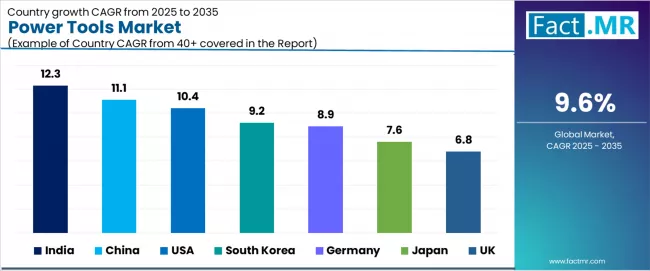
| Region/Country | 2025 to 2035 Growth | How to win | What to watch out |
|---|---|---|---|
| India | 12.3% | Focus on affordable cordless platforms | Infrastructure gaps; distribution challenges |
| China | 11.1% | Lead with manufacturing-grade tools | Intense competition; price pressures |
| usa | 10.4% | Provide premium battery ecosystems | Market saturation; replacement cycles |
| South Korea | 9.2% | Offer precision electronics tools | Niche market focus; limited scale |
| Germany | 8.9% | Deliver industrial automation integration | Conservative adoption; quality expectations |
| Japan | 7.6% | Maintain precision engineering focus | Mature market dynamics; demographic challenges |
| UK | 6.8% | Push renovation-focused solutions | Economic uncertainty; market maturity |
India Drives Fastest Market Growth
India establishes fastest market growth through progressive construction sector expansion and comprehensive infrastructure development programs, positioning power tool technologies as essential equipment in residential building operations and emerging industrial manufacturing facilities.
The country's 12.3% growth rate reflects rising construction activity supporting contractor equipment demand and growing DIY penetration among middle-class consumers that encourages the deployment of affordable cordless tools in diverse application settings. Growth concentrates in major metropolitan regions, including Mumbai, Delhi, and Bangalore, where construction firms showcase increasing investment capacity for professional-grade equipment that appeals to quality-conscious contractors demanding reliable performance and competitive pricing structures.
Indian construction contractors are developing standardized tool procurement protocols that combine international brand quality with domestic distribution partnerships, including tool rental service expansion and contractor financing program growth. Distribution infrastructure through hardware retailers and online platforms expands product access, while contractor training initiatives support adoption across diverse project types and skill specialization levels.
China Emerges as Manufacturing Powerhouse
In Guangzhou, Shanghai, and Shenzhen regions, manufacturing facilities and construction companies are adopting power tool technologies as essential productivity equipment for industrial operations, driven by strong manufacturing ouTPUt growth and expanding export production capabilities that emphasize the importance of efficient assembly solutions.
The market holds an 11.1% growth rate, supported by government infrastructure initiatives and manufacturing modernization programs that promote advanced tool adoption for quality improvement applications.
Chinese manufacturers are favoring high-volume production tools that provide consistent performance and durability characteristics, particularly appealing in export-oriented markets where production efficiency and quality consistency represent critical competitive factors.
Market expansion benefits from substantial manufacturing investment and technical training program establishment that enable widespread adoption of automated assembly technologies for diverse industrial and construction applications. Industry adoption follows patterns established in manufacturing equipment success, where productivity advantages and operational reliability drive procurement preference and long-term supplier relationships.
USA Shows Cordless Technology Leadership
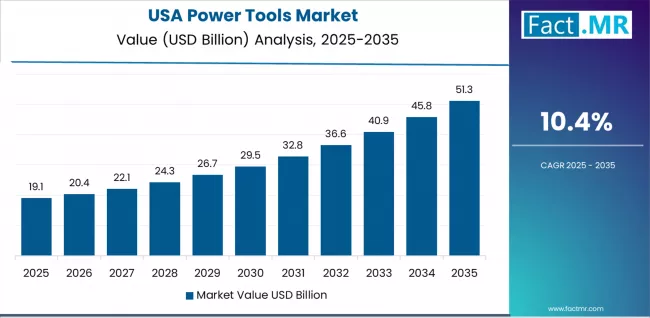
USA establishes cordless technology leadership through comprehensive battery platform development and established professional contractor ecosystem, integrating power tool technologies across residential construction, commercial projects, and industrial manufacturing operations. The country's 10.4% growth rate reflects high cordless adoption patterns and sophisticated tool system maturity that support widespread deployment of battery-powered equipment in professional contractor applications.
Growth concentrates in established construction markets, including Texas, California, and Florida regions, where contractors showcase advanced cordless fleet management that appeals to productivity-focused professionals seeking comprehensive battery ecosystem integration and tool interoperability advantages.
American contractors leverage established manufacturer partnerships and comprehensive warranty frameworks, including tool tracking systems and fleet management programs that create operational efficiency and asset protection assurance. The market benefits from substantial innovation investments and professional training initiatives that encourage premium tool adoption while supporting continuous technology advancement and safety standard improvements.
South Korea Shows Electronics Integration Excellence
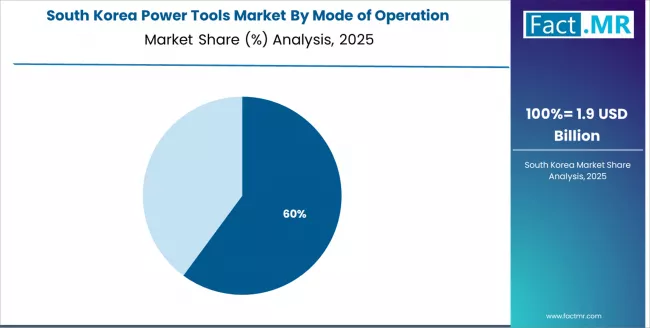
South Korea's advanced manufacturing market demonstrates sophisticated power tool integration with documented precision emphasis in electronics assembly and automotive production through specialized manufacturing facilities and established industrial equipment networks. The country leverages advanced automation capabilities and quality control approaches to maintain a 9.2% growth rate.
Premium manufacturing centers, including Seoul metropolitan area, Ulsan, and Busan regions, showcase technical sophistication priorities where power tool technologies integrate with established electronics manufacturing expertise and precision assembly practices to optimize production quality and ensure appropriate torque control accuracy.
South Korean manufacturers prioritize precision tool validation and comprehensive quality documentation in equipment selection processes, creating demand for certified tools with proven characteristics, including torque accuracy specifications, repeatability documentation, and traceability compliance. The market benefits from established electronics industry reputation and manufacturing excellence culture that provide premium positioning opportunities and compliance with strict industrial quality standards.
Germany Shows Industrial Precision Leadership
Germany's advanced industrial market demonstrates sophisticated power tool integration with documented quality emphasis in manufacturing precision and engineering excellence through specialized automotive manufacturers and established machine building networks. The country leverages rigorous quality standards and comprehensive automation approaches to maintain an 8.9% growth rate.
Premium manufacturing regions, including Baden-Württemberg, Bavaria, and North Rhine-Westphalia, showcase precision-focused priorities where power tool technologies integrate with established engineering cultures and meticulous assembly practices to optimize manufacturing quality and maintain production consistency under demanding automotive requirements.
German manufacturers prioritize tool certification requirements and comprehensive performance validation in equipment procurement processes, creating demand for extensively-tested tools with proven characteristics, including long-term durability data, precision specifications, and comprehensive safety certifications. The market benefits from established manufacturing reputation and quality-focused industrial culture that provide differentiation opportunities and compliance with strict German industrial safety regulations.
Japan Shows Precision Tool Excellence

Japan's sophisticated manufacturing market demonstrates established power tool utilization with documented quality emphasis in precision assembly and manufacturing excellence through comprehensive industrial facilities and electronics production networks. The country maintains a 7.6% growth rate, leveraging advanced quality standards and precision-focused manufacturing practices in tool technology deployment.
Metropolitan manufacturing regions, including Tokyo, Osaka, and Nagoya areas, showcase technical precision priorities where power tool technologies integrate with established manufacturing expertise and meticulous quality control to optimize assembly accuracy and maintain consistent production standards under demanding electronics requirements.
Japanese manufacturers prioritize minimal variation approaches and consistent tool performance in equipment selection, creating demand for high-reliability products with predictable operation, including tight tolerance specifications and comprehensive quality documentation. The market benefits from established manufacturing industry reputation and precision engineering culture that provide premium positioning opportunities and comply with strict Japanese industrial standards.
UK Shows Renovation Market Focus
UK's mature construction market demonstrates established power tool adoption with documented integration in residential renovation projects and commercial building maintenance through comprehensive contractor networks and DIY retail infrastructure. The country maintains a 6.8% growth rate, leveraging steady infrastructure renovation cycles and heritage building preservation in construction activity maintenance.
Construction regions, including London, Manchester, and Birmingham areas, showcase renovation-focused priorities where power tool technologies integrate with established contractor practices and building code compliance to optimize project execution and maintain quality standards under heritage preservation requirements.
UK contractors prioritize cordless convenience features and compact tool designs in equipment selection, creating demand for versatile products with space-saving characteristics, including multi-functional capabilities and comprehensive accessory systems. The market benefits from established DIY culture and home improvement television programming that provide consumer awareness advantages and support residential tool market development.
Europe Market Split by Country
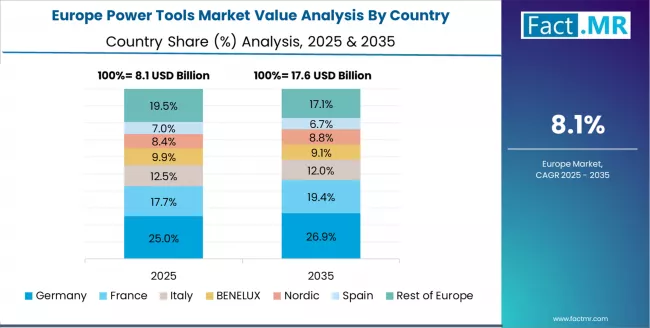
The European power tools market is projected to grow from USD 8.3 billion in 2025 to USD 20.2 billion by 2035, representing 23.9% of the global market in 2025 and expanding to 23.4% by 2035. Germany is expected to maintain its leadership position with USD 2.2 billion in 2025, accounting for 26.8% of the European market, supported by its advanced manufacturing infrastructure and established industrial tool networks.
France follows with USD 1.6 billion, representing 18.9% of the European market in 2025, driven by comprehensive construction sector integration and renovation market activity. UK holds USD 1.4 billion with 17.3% market share through established DIY retail presence and contractor equipment networks.
Italy commands USD 1.2 billion representing 14.2% share, while Spain accounts for USD 1.0 billion or 11.6% in 2025. The rest of Europe region maintains USD 0.9 billion, representing 11.2% of the European market, attributed to increasing power tool adoption in Nordic countries and emerging Eastern European construction sectors implementing modernization programs.
Competitive Landscape of the Power Tools Market
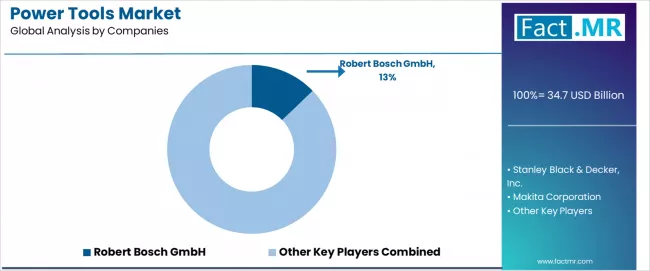
The power tools market exhibits a moderately consolidated competitive structure with approximately 40-70 active players operating across global manufacturing networks and regional equipment distribution portfolios. Robert Bosch GmbH maintains market leadership at a 12.8% share, reflecting strong product portfolio positioning across diverse tool categories with sophisticated global distribution strategies.
This competitive landscape demonstrates the maturation of power tool technology, where established players leverage brand recognition advantages, extensive innovation capabilities, and professional contractor relationships to maintain dominant positions, while emerging smart tool developers and battery technology specialists create niche opportunities through connected platforms and advanced energy storage solutions.
Market leadership is maintained through several critical competitive advantages extending beyond manufacturing capabilities and product portfolios. Global distribution networks enable leading players to navigate diverse market requirements and access varied customer segments including professional contractors, industrial manufacturers, and consumer DIY users.
Innovation infrastructure and research development capability availability represent crucial differentiators in power tool categories, where decades of motor technology expertise, battery system development, and ergonomic design frameworks create purchasing preference among quality-focused professionals.
Manufacturing efficiency in automated production facilities, supply chain component sourcing, and quality control systems separate major brands from smaller competitors, while comprehensive warranty programs addressing product durability, service networks, and replacement part availability strengthen market position and user confidence.
The market demonstrates emerging differentiation opportunities in smart tool categories and brushless motor technologies, where traditional brushed motor tools face competition from efficiency-focused entrants offering maintenance-free advantages. However, significant competitive advantages persist in established cordless platform categories through comprehensive battery ecosystem portfolios and contractor loyalty depth.
Premium positioning strategies with advanced battery technologies and intelligent tool features command margin premiums through superior runtime performance and connectivity capabilities. Comprehensive tool system portfolios combining multiple product categories with unified battery platforms create integrated positioning that justifies higher price points beyond standalone tool competition. Complete contractor solution offerings emphasizing training programs, warranty services, and fleet management systems generate brand loyalty and platform preferences beyond transactional tool purchases.
| Stakeholder | What they actually control | Typical strengths | Typical blind spots |
|---|---|---|---|
| Global power tool manufacturers | Comprehensive product portfolios; global distribution; R&D capabilities; manufacturing scale | Brand recognition; innovation resources; contractor relationships; quality reputation | Regional customization; niche applications; pricing flexibility; startup agility |
| Specialized professional tool brands | Premium positioning; contractor loyalty; service networks; technical expertise | Product quality; professional focus; reliability reputation; service excellence | Cost competitiveness; consumer segments; distribution breadth; volume scale |
| Regional manufacturers | Local production; cost optimization; regional distribution; market proximity | Affordability positioning; delivery responsiveness; local support; cultural understanding | Brand recognition; technology advancement; international expansion; R&D investment |
| Battery technology specialists | Energy storage innovation; charging systems; battery management; platform integration | Technical sophistication; efficiency leadership; patent portfolios; system optimization | Tool design; contractor relationships; distribution channels; brand awareness |
| Retail distribution networks | Customer access; inventory management; consumer insights; merchandising control | Market reach; consumer intimacy; purchasing volume; promotional capabilities | Product development; technical expertise; manufacturer relationships; innovation influence |
Key Players in the Power Tools Market
- Robert Bosch GmbH
- Stanley Black & Decker, Inc.
- Makita Corporation
- Hilti Corporation
- Techtronic Industries Company Limited (TTI)
- Snap-on Incorporated
- Husqvarna Group
- Festool GmbH (TTS Tooltechnic Systems AG & Co. KG)
- Atlas Copco AB
- HiKOKI Power Tools (Koki Holdings Co., Ltd.)
Scope of the Report
| Items | Values |
|---|---|
| Quantitative Units (2025) | USD 34.7 billion |
| Product Type | Drills, Saws, Sanders, Wrenches, Others (Grinders, Routers, Polishers) |
| Mode of Operation | Cordless, Corded |
| Application | Industrial, Residential, Commercial |
| Regions Covered | North America, Europe, Asia Pacific, Latin America, mea |
| Countries Covered | usa, China, India, Germany, Japan, UK, South Korea, and 15+ additional countries |
| Key Companies Profiled | Bosch, Stanley Black & Decker, Makita Corporation, Hilti Corporation, Techtronic Industries, Snap-on Incorporated, Husqvarna, Festool |
| Additional Attributes | Dollar sales by product and mode categories, regional adoption trends across Asia Pacific, North America, and Europe, competitive landscape with global power tool manufacturers and specialized professional brands, contractor preferences for cordless platforms and battery ecosystem integration, integration with construction contractors and industrial manufacturers, innovations in brushless motor technologies and smart tool connectivity, and development of comprehensive tool system platforms with enhanced battery performance and integrated fleet management capabilities. |
Power Tools Market by Segments
-
Product Type :
- Drills
- Hammer Drills
- Rotary Drills
- Saws
- Circular Saw
- Reciprocating Saw
- Sanders
- Belt Sander
- Orbital Sander
- Wrenches
- Impact Wrench
- Torque Wrench
- Others
- Grinders
- Routers
- Polishers
- Drills
-
Mode of Operation :
- Cordless
- Corded
-
Application :
- Industrial
- Residential
- Commercial
-
Region :
- North America
- usa
- Canada
- Mexico
- Europe
- Germany
- France
- UK
- Italy
- Spain
- Rest of Europe
- Asia Pacific
- China
- India
- Japan
- South Korea
- ASEAN
- Australia & New Zealand
- Rest of Asia Pacific
- Latin America
- Brazil
- Rest of Latin America
- mea
- GCC Countries
- South Africa
- Rest of mea
- North America
Table of Content
- Executive Summary
- Global Market Outlook
- Demand to side Trends
- Supply to side Trends
- Technology Roadmap Analysis
- Analysis and Recommendations
- Market Overview
- Market Coverage / Taxonomy
- Market Definition / Scope / Limitations
- Market Background
- Market Dynamics
- Drivers
- Restraints
- Opportunity
- Trends
- Scenario Forecast
- Demand in Optimistic Scenario
- Demand in Likely Scenario
- Demand in Conservative Scenario
- Opportunity Map Analysis
- Product Life Cycle Analysis
- Supply Chain Analysis
- Investment Feasibility Matrix
- Value Chain Analysis
- PESTLE and Porter’s Analysis
- Regulatory Landscape
- Regional Parent Market Outlook
- Production and Consumption Statistics
- Import and Export Statistics
- Market Dynamics
- Global Market Analysis 2020 to 2024 and Forecast, 2025 to 2035
- Historical Market Size Value (USD Million) Analysis, 2020 to 2024
- Current and Future Market Size Value (USD Million) Projections, 2025 to 2035
- Y to o to Y Growth Trend Analysis
- Absolute $ Opportunity Analysis
- Global Market Pricing Analysis 2020 to 2024 and Forecast 2025 to 2035
- Global Market Analysis 2020 to 2024 and Forecast 2025 to 2035, By Product Type
- Introduction / Key Findings
- Historical Market Size Value (USD Million) Analysis By Product Type, 2020 to 2024
- Current and Future Market Size Value (USD Million) Analysis and Forecast By Product Type, 2025 to 2035
- Drills
- Saws
- Sanders
- Wrenches
- Others
- Y to o to Y Growth Trend Analysis By Product Type, 2020 to 2024
- Absolute $ Opportunity Analysis By Product Type, 2025 to 2035
- Global Market Analysis 2020 to 2024 and Forecast 2025 to 2035, By Mode of Operation
- Introduction / Key Findings
- Historical Market Size Value (USD Million) Analysis By Mode of Operation, 2020 to 2024
- Current and Future Market Size Value (USD Million) Analysis and Forecast By Mode of Operation, 2025 to 2035
- Cordless
- Corded
- Y to o to Y Growth Trend Analysis By Mode of Operation, 2020 to 2024
- Absolute $ Opportunity Analysis By Mode of Operation, 2025 to 2035
- Global Market Analysis 2020 to 2024 and Forecast 2025 to 2035, By Application
- Introduction / Key Findings
- Historical Market Size Value (USD Million) Analysis By Application, 2020 to 2024
- Current and Future Market Size Value (USD Million) Analysis and Forecast By Application, 2025 to 2035
- Industrial
- Residential
- Commercial
- Y to o to Y Growth Trend Analysis By Application, 2020 to 2024
- Absolute $ Opportunity Analysis By Application, 2025 to 2035
- Global Market Analysis 2020 to 2024 and Forecast 2025 to 2035, By Region
- Introduction
- Historical Market Size Value (USD Million) Analysis By Region, 2020 to 2024
- Current Market Size Value (USD Million) Analysis and Forecast By Region, 2025 to 2035
- North America
- Latin America
- Western Europe
- Eastern Europe
- East Asia
- South Asia and Pacific
- Middle East & Africa
- Market Attractiveness Analysis By Region
- North America Market Analysis 2020 to 2024 and Forecast 2025 to 2035, By Country
- Historical Market Size Value (USD Million) Trend Analysis By Market Taxonomy, 2020 to 2024
- Market Size Value (USD Million) Forecast By Market Taxonomy, 2025 to 2035
- By Country
- USA
- Canada
- Mexico
- By Product Type
- By Mode of Operation
- By Application
- By Country
- Market Attractiveness Analysis
- By Country
- By Product Type
- By Mode of Operation
- By Application
- Key Takeaways
- Latin America Market Analysis 2020 to 2024 and Forecast 2025 to 2035, By Country
- Historical Market Size Value (USD Million) Trend Analysis By Market Taxonomy, 2020 to 2024
- Market Size Value (USD Million) Forecast By Market Taxonomy, 2025 to 2035
- By Country
- Brazil
- Chile
- Rest of Latin America
- By Product Type
- By Mode of Operation
- By Application
- By Country
- Market Attractiveness Analysis
- By Country
- By Product Type
- By Mode of Operation
- By Application
- Key Takeaways
- Western Europe Market Analysis 2020 to 2024 and Forecast 2025 to 2035, By Country
- Historical Market Size Value (USD Million) Trend Analysis By Market Taxonomy, 2020 to 2024
- Market Size Value (USD Million) Forecast By Market Taxonomy, 2025 to 2035
- By Country
- Germany
- UK
- Italy
- Spain
- France
- Nordic
- BENELUX
- Rest of Western Europe
- By Product Type
- By Mode of Operation
- By Application
- By Country
- Market Attractiveness Analysis
- By Country
- By Product Type
- By Mode of Operation
- By Application
- Key Takeaways
- Eastern Europe Market Analysis 2020 to 2024 and Forecast 2025 to 2035, By Country
- Historical Market Size Value (USD Million) Trend Analysis By Market Taxonomy, 2020 to 2024
- Market Size Value (USD Million) Forecast By Market Taxonomy, 2025 to 2035
- By Country
- Russia
- Poland
- Hungary
- Balkan & Baltic
- Rest of Eastern Europe
- By Product Type
- By Mode of Operation
- By Application
- By Country
- Market Attractiveness Analysis
- By Country
- By Product Type
- By Mode of Operation
- By Application
- Key Takeaways
- East Asia Market Analysis 2020 to 2024 and Forecast 2025 to 2035, By Country
- Historical Market Size Value (USD Million) Trend Analysis By Market Taxonomy, 2020 to 2024
- Market Size Value (USD Million) Forecast By Market Taxonomy, 2025 to 2035
- By Country
- China
- Japan
- South Korea
- By Product Type
- By Mode of Operation
- By Application
- By Country
- Market Attractiveness Analysis
- By Country
- By Product Type
- By Mode of Operation
- By Application
- Key Takeaways
- South Asia and Pacific Market Analysis 2020 to 2024 and Forecast 2025 to 2035, By Country
- Historical Market Size Value (USD Million) Trend Analysis By Market Taxonomy, 2020 to 2024
- Market Size Value (USD Million) Forecast By Market Taxonomy, 2025 to 2035
- By Country
- India
- ASEAN
- Australia & New Zealand
- Rest of South Asia and Pacific
- By Product Type
- By Mode of Operation
- By Application
- By Country
- Market Attractiveness Analysis
- By Country
- By Product Type
- By Mode of Operation
- By Application
- Key Takeaways
- Middle East & Africa Market Analysis 2020 to 2024 and Forecast 2025 to 2035, By Country
- Historical Market Size Value (USD Million) Trend Analysis By Market Taxonomy, 2020 to 2024
- Market Size Value (USD Million) Forecast By Market Taxonomy, 2025 to 2035
- By Country
- Kingdom of Saudi Arabia
- Other GCC Countries
- Turkiye
- South Africa
- Other African Union
- Rest of Middle East & Africa
- By Product Type
- By Mode of Operation
- By Application
- By Country
- Market Attractiveness Analysis
- By Country
- By Product Type
- By Mode of Operation
- By Application
- Key Takeaways
- Key Countries Market Analysis
- USA
- Pricing Analysis
- Market Share Analysis, 2024
- By Product Type
- By Mode of Operation
- By Application
- Canada
- Pricing Analysis
- Market Share Analysis, 2024
- By Product Type
- By Mode of Operation
- By Application
- Mexico
- Pricing Analysis
- Market Share Analysis, 2024
- By Product Type
- By Mode of Operation
- By Application
- Brazil
- Pricing Analysis
- Market Share Analysis, 2024
- By Product Type
- By Mode of Operation
- By Application
- Chile
- Pricing Analysis
- Market Share Analysis, 2024
- By Product Type
- By Mode of Operation
- By Application
- Germany
- Pricing Analysis
- Market Share Analysis, 2024
- By Product Type
- By Mode of Operation
- By Application
- UK
- Pricing Analysis
- Market Share Analysis, 2024
- By Product Type
- By Mode of Operation
- By Application
- Italy
- Pricing Analysis
- Market Share Analysis, 2024
- By Product Type
- By Mode of Operation
- By Application
- Spain
- Pricing Analysis
- Market Share Analysis, 2024
- By Product Type
- By Mode of Operation
- By Application
- France
- Pricing Analysis
- Market Share Analysis, 2024
- By Product Type
- By Mode of Operation
- By Application
- India
- Pricing Analysis
- Market Share Analysis, 2024
- By Product Type
- By Mode of Operation
- By Application
- ASEAN
- Pricing Analysis
- Market Share Analysis, 2024
- By Product Type
- By Mode of Operation
- By Application
- Australia & New Zealand
- Pricing Analysis
- Market Share Analysis, 2024
- By Product Type
- By Mode of Operation
- By Application
- China
- Pricing Analysis
- Market Share Analysis, 2024
- By Product Type
- By Mode of Operation
- By Application
- Japan
- Pricing Analysis
- Market Share Analysis, 2024
- By Product Type
- By Mode of Operation
- By Application
- South Korea
- Pricing Analysis
- Market Share Analysis, 2024
- By Product Type
- By Mode of Operation
- By Application
- Russia
- Pricing Analysis
- Market Share Analysis, 2024
- By Product Type
- By Mode of Operation
- By Application
- Poland
- Pricing Analysis
- Market Share Analysis, 2024
- By Product Type
- By Mode of Operation
- By Application
- Hungary
- Pricing Analysis
- Market Share Analysis, 2024
- By Product Type
- By Mode of Operation
- By Application
- Kingdom of Saudi Arabia
- Pricing Analysis
- Market Share Analysis, 2024
- By Product Type
- By Mode of Operation
- By Application
- Turkiye
- Pricing Analysis
- Market Share Analysis, 2024
- By Product Type
- By Mode of Operation
- By Application
- South Africa
- Pricing Analysis
- Market Share Analysis, 2024
- By Product Type
- By Mode of Operation
- By Application
- USA
- Market Structure Analysis
- Competition Dashboard
- Competition Benchmarking
- Market Share Analysis of Top Players
- By Regional
- By Product Type
- By Mode of Operation
- By Application
- Competition Analysis
- Competition Deep Dive
- Robert Bosch GmbH
- Overview
- Product Portfolio
- Profitability by Market Segments (Product/Age /Sales Channel/Region)
- Sales Footprint
- Strategy Overview
- Marketing Strategy
- Product Strategy
- Channel Strategy
- Stanley Black & Decker, Inc.
- Makita Corporation
- Hilti Corporation
- Techtronic Industries Company Limited (TTI)
- Snap-on Incorporated
- Husqvarna Group
- Festool GmbH (TTS Tooltechnic Systems AG & Co. KG)
- Atlas Copco AB
- HiKOKI Power Tools (Koki Holdings Co., Ltd.)
- Robert Bosch GmbH
- Competition Deep Dive
- Assumptions & Acronyms Used
- Research Methodology
List Of Table
- Table 1: Global Market Value (USD Million) Forecast by Region, 2020 to 2035
- Table 2: Global Market Value (USD Million) Forecast by Product Type, 2020 to 2035
- Table 3: Global Market Value (USD Million) Forecast by Mode of Operation, 2020 to 2035
- Table 4: Global Market Value (USD Million) Forecast by Application, 2020 to 2035
- Table 5: North America Market Value (USD Million) Forecast by Country, 2020 to 2035
- Table 6: North America Market Value (USD Million) Forecast by Product Type, 2020 to 2035
- Table 7: North America Market Value (USD Million) Forecast by Mode of Operation, 2020 to 2035
- Table 8: North America Market Value (USD Million) Forecast by Application, 2020 to 2035
- Table 9: Latin America Market Value (USD Million) Forecast by Country, 2020 to 2035
- Table 10: Latin America Market Value (USD Million) Forecast by Product Type, 2020 to 2035
- Table 11: Latin America Market Value (USD Million) Forecast by Mode of Operation, 2020 to 2035
- Table 12: Latin America Market Value (USD Million) Forecast by Application, 2020 to 2035
- Table 13: Western Europe Market Value (USD Million) Forecast by Country, 2020 to 2035
- Table 14: Western Europe Market Value (USD Million) Forecast by Product Type, 2020 to 2035
- Table 15: Western Europe Market Value (USD Million) Forecast by Mode of Operation, 2020 to 2035
- Table 16: Western Europe Market Value (USD Million) Forecast by Application, 2020 to 2035
- Table 17: Eastern Europe Market Value (USD Million) Forecast by Country, 2020 to 2035
- Table 18: Eastern Europe Market Value (USD Million) Forecast by Product Type, 2020 to 2035
- Table 19: Eastern Europe Market Value (USD Million) Forecast by Mode of Operation, 2020 to 2035
- Table 20: Eastern Europe Market Value (USD Million) Forecast by Application, 2020 to 2035
- Table 21: East Asia Market Value (USD Million) Forecast by Country, 2020 to 2035
- Table 22: East Asia Market Value (USD Million) Forecast by Product Type, 2020 to 2035
- Table 23: East Asia Market Value (USD Million) Forecast by Mode of Operation, 2020 to 2035
- Table 24: East Asia Market Value (USD Million) Forecast by Application, 2020 to 2035
- Table 25: South Asia and Pacific Market Value (USD Million) Forecast by Country, 2020 to 2035
- Table 26: South Asia and Pacific Market Value (USD Million) Forecast by Product Type, 2020 to 2035
- Table 27: South Asia and Pacific Market Value (USD Million) Forecast by Mode of Operation, 2020 to 2035
- Table 28: South Asia and Pacific Market Value (USD Million) Forecast by Application, 2020 to 2035
- Table 29: Middle East & Africa Market Value (USD Million) Forecast by Country, 2020 to 2035
- Table 30: Middle East & Africa Market Value (USD Million) Forecast by Product Type, 2020 to 2035
- Table 31: Middle East & Africa Market Value (USD Million) Forecast by Mode of Operation, 2020 to 2035
- Table 32: Middle East & Africa Market Value (USD Million) Forecast by Application, 2020 to 2035
List Of Figures
- Figure 1: Global Market Pricing Analysis
- Figure 2: Global Market Value (USD Million) Forecast 2020 to 2035
- Figure 3: Global Market Value Share and BPS Analysis by Product Type, 2025 and 2035
- Figure 4: Global Market Y to o to Y Growth Comparison by Product Type, 2025 to 2035
- Figure 5: Global Market Attractiveness Analysis by Product Type
- Figure 6: Global Market Value Share and BPS Analysis by Mode of Operation, 2025 and 2035
- Figure 7: Global Market Y to o to Y Growth Comparison by Mode of Operation, 2025 to 2035
- Figure 8: Global Market Attractiveness Analysis by Mode of Operation
- Figure 9: Global Market Value Share and BPS Analysis by Application, 2025 and 2035
- Figure 10: Global Market Y to o to Y Growth Comparison by Application, 2025 to 2035
- Figure 11: Global Market Attractiveness Analysis by Application
- Figure 12: Global Market Value (USD Million) Share and BPS Analysis by Region, 2025 and 2035
- Figure 13: Global Market Y to o to Y Growth Comparison by Region, 2025 to 2035
- Figure 14: Global Market Attractiveness Analysis by Region
- Figure 15: North America Market Incremental Dollar Opportunity, 2025 to 2035
- Figure 16: Latin America Market Incremental Dollar Opportunity, 2025 to 2035
- Figure 17: Western Europe Market Incremental Dollar Opportunity, 2025 to 2035
- Figure 18: Eastern Europe Market Incremental Dollar Opportunity, 2025 to 2035
- Figure 19: East Asia Market Incremental Dollar Opportunity, 2025 to 2035
- Figure 20: South Asia and Pacific Market Incremental Dollar Opportunity, 2025 to 2035
- Figure 21: Middle East & Africa Market Incremental Dollar Opportunity, 2025 to 2035
- Figure 22: North America Market Value Share and BPS Analysis by Country, 2025 and 2035
- Figure 23: North America Market Value Share and BPS Analysis by Product Type, 2025 and 2035
- Figure 24: North America Market Y to o to Y Growth Comparison by Product Type, 2025 to 2035
- Figure 25: North America Market Attractiveness Analysis by Product Type
- Figure 26: North America Market Value Share and BPS Analysis by Mode of Operation, 2025 and 2035
- Figure 27: North America Market Y to o to Y Growth Comparison by Mode of Operation, 2025 to 2035
- Figure 28: North America Market Attractiveness Analysis by Mode of Operation
- Figure 29: North America Market Value Share and BPS Analysis by Application, 2025 and 2035
- Figure 30: North America Market Y to o to Y Growth Comparison by Application, 2025 to 2035
- Figure 31: North America Market Attractiveness Analysis by Application
- Figure 32: Latin America Market Value Share and BPS Analysis by Country, 2025 and 2035
- Figure 33: Latin America Market Value Share and BPS Analysis by Product Type, 2025 and 2035
- Figure 34: Latin America Market Y to o to Y Growth Comparison by Product Type, 2025 to 2035
- Figure 35: Latin America Market Attractiveness Analysis by Product Type
- Figure 36: Latin America Market Value Share and BPS Analysis by Mode of Operation, 2025 and 2035
- Figure 37: Latin America Market Y to o to Y Growth Comparison by Mode of Operation, 2025 to 2035
- Figure 38: Latin America Market Attractiveness Analysis by Mode of Operation
- Figure 39: Latin America Market Value Share and BPS Analysis by Application, 2025 and 2035
- Figure 40: Latin America Market Y to o to Y Growth Comparison by Application, 2025 to 2035
- Figure 41: Latin America Market Attractiveness Analysis by Application
- Figure 42: Western Europe Market Value Share and BPS Analysis by Country, 2025 and 2035
- Figure 43: Western Europe Market Value Share and BPS Analysis by Product Type, 2025 and 2035
- Figure 44: Western Europe Market Y to o to Y Growth Comparison by Product Type, 2025 to 2035
- Figure 45: Western Europe Market Attractiveness Analysis by Product Type
- Figure 46: Western Europe Market Value Share and BPS Analysis by Mode of Operation, 2025 and 2035
- Figure 47: Western Europe Market Y to o to Y Growth Comparison by Mode of Operation, 2025 to 2035
- Figure 48: Western Europe Market Attractiveness Analysis by Mode of Operation
- Figure 49: Western Europe Market Value Share and BPS Analysis by Application, 2025 and 2035
- Figure 50: Western Europe Market Y to o to Y Growth Comparison by Application, 2025 to 2035
- Figure 51: Western Europe Market Attractiveness Analysis by Application
- Figure 52: Eastern Europe Market Value Share and BPS Analysis by Country, 2025 and 2035
- Figure 53: Eastern Europe Market Value Share and BPS Analysis by Product Type, 2025 and 2035
- Figure 54: Eastern Europe Market Y to o to Y Growth Comparison by Product Type, 2025 to 2035
- Figure 55: Eastern Europe Market Attractiveness Analysis by Product Type
- Figure 56: Eastern Europe Market Value Share and BPS Analysis by Mode of Operation, 2025 and 2035
- Figure 57: Eastern Europe Market Y to o to Y Growth Comparison by Mode of Operation, 2025 to 2035
- Figure 58: Eastern Europe Market Attractiveness Analysis by Mode of Operation
- Figure 59: Eastern Europe Market Value Share and BPS Analysis by Application, 2025 and 2035
- Figure 60: Eastern Europe Market Y to o to Y Growth Comparison by Application, 2025 to 2035
- Figure 61: Eastern Europe Market Attractiveness Analysis by Application
- Figure 62: East Asia Market Value Share and BPS Analysis by Country, 2025 and 2035
- Figure 63: East Asia Market Value Share and BPS Analysis by Product Type, 2025 and 2035
- Figure 64: East Asia Market Y to o to Y Growth Comparison by Product Type, 2025 to 2035
- Figure 65: East Asia Market Attractiveness Analysis by Product Type
- Figure 66: East Asia Market Value Share and BPS Analysis by Mode of Operation, 2025 and 2035
- Figure 67: East Asia Market Y to o to Y Growth Comparison by Mode of Operation, 2025 to 2035
- Figure 68: East Asia Market Attractiveness Analysis by Mode of Operation
- Figure 69: East Asia Market Value Share and BPS Analysis by Application, 2025 and 2035
- Figure 70: East Asia Market Y to o to Y Growth Comparison by Application, 2025 to 2035
- Figure 71: East Asia Market Attractiveness Analysis by Application
- Figure 72: South Asia and Pacific Market Value Share and BPS Analysis by Country, 2025 and 2035
- Figure 73: South Asia and Pacific Market Value Share and BPS Analysis by Product Type, 2025 and 2035
- Figure 74: South Asia and Pacific Market Y to o to Y Growth Comparison by Product Type, 2025 to 2035
- Figure 75: South Asia and Pacific Market Attractiveness Analysis by Product Type
- Figure 76: South Asia and Pacific Market Value Share and BPS Analysis by Mode of Operation, 2025 and 2035
- Figure 77: South Asia and Pacific Market Y to o to Y Growth Comparison by Mode of Operation, 2025 to 2035
- Figure 78: South Asia and Pacific Market Attractiveness Analysis by Mode of Operation
- Figure 79: South Asia and Pacific Market Value Share and BPS Analysis by Application, 2025 and 2035
- Figure 80: South Asia and Pacific Market Y to o to Y Growth Comparison by Application, 2025 to 2035
- Figure 81: South Asia and Pacific Market Attractiveness Analysis by Application
- Figure 82: Middle East & Africa Market Value Share and BPS Analysis by Country, 2025 and 2035
- Figure 83: Middle East & Africa Market Value Share and BPS Analysis by Product Type, 2025 and 2035
- Figure 84: Middle East & Africa Market Y to o to Y Growth Comparison by Product Type, 2025 to 2035
- Figure 85: Middle East & Africa Market Attractiveness Analysis by Product Type
- Figure 86: Middle East & Africa Market Value Share and BPS Analysis by Mode of Operation, 2025 and 2035
- Figure 87: Middle East & Africa Market Y to o to Y Growth Comparison by Mode of Operation, 2025 to 2035
- Figure 88: Middle East & Africa Market Attractiveness Analysis by Mode of Operation
- Figure 89: Middle East & Africa Market Value Share and BPS Analysis by Application, 2025 and 2035
- Figure 90: Middle East & Africa Market Y to o to Y Growth Comparison by Application, 2025 to 2035
- Figure 91: Middle East & Africa Market Attractiveness Analysis by Application
- Figure 92: Global Market - Tier Structure Analysis
- Figure 93: Global Market - Company Share Analysis
- FAQs -
How big is the power tools market in 2025?
The global power tools market is estimated to be valued at USD 34.7 billion in 2025.
What will be the size of power tools market in 2035?
The market size for the power tools market is projected to reach USD 86.5 billion by 2035.
How much will be the power tools market growth between 2025 and 2035?
The power tools market is expected to grow at a 9.6% CAGR between 2025 and 2035.
What are the key product types in the power tools market?
The key product types in power tools market are drills, saws, sanders, wrenches and others.
Which mode of operation segment to contribute significant share in the power tools market in 2025?
In terms of mode of operation, cordless segment to command 63.1% share in the power tools market in 2025.